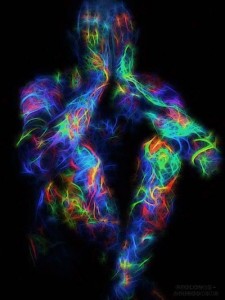
Tag Archives: personal power
In the first half of this article, we explored my introduction to dream work when living at Pecos Benedictine Monastery during the late 70’s. Two dream experiences there left significant impressions on me. Becky’s story was one of them. A brief encounter with a renowned author who did a quick analysis of one of my dreams was the second.
Becky was being visited in her dreams regularly by a horrific monster that would come down out of the mountains surrounding the monastery and attack her. Initially her fright was paralyzing, but through dream work with her spiritual director, Becky experienced something shift. Using a Gestalt-type dream exercise, Becky eventually was able to imagine talking with the mountain monster. The only thing separating her from the creature, as her active imagination formed the experience, was a wrought iron gate at the entrance to the monastery.
This close encounter with her nightmare monster shifted for Becky a dialogue that was once unfathomable, into an exchange that felt relatively safe.
So, what’s the point? In the Gestalt system of belief, all parts of the dream are highly loaded symbols for parts of the dreamer. For example, in Becky’s dream, the mountains represented some part of her, as did the gate around the monastery, as well as the monastery itself. In keeping with the Gestalt approach, the mountain monster was also representing some aspect of Becky.
What Becky discovered was that the monster represented her own healthy power that she was cut off from. As she became acquainted through the exercise with the mountain monster, she was refamiliarizing herself with this powerful aspect of self. But since Becky had been separate from her healthy power for so long, that power had come to terrify her. This became apparent as Becky activated the mountain monster symbol through the dream exercise.
But as Becky got to know her own power shown to her as the monster, she felt safer in the world. Imagine Becky speaking these words as she role-played the awful beast of her dreams: “I AM THE MOST POWERFUL!” As she felt those words come out of her, Becky began to integrate the strength of her demon. Imagine the force of the mountain monster now her ally.
The second dream work experience that left a lasting impression on me was related to one of my own nightmares. Morton Kelsey was an internationally recognized Jungian author and dream work expert who came to present for all of us living at the monastery back in 1977.
During the presentation break, I was privileged to snag five minutes of Mr. Kelsey’s time. I gave him a brief description of a disturbing dream I’d had. He made one statement about my dream: probably no more than ten words. And while I had some understanding of the meaning of his words at the time, it’s only been in the last year that a more complete comprehension has landed with me. Given only a three minute description of my nightmare, Mr. Kelsey knew something about me that took me almost 40 more years to see.
This is the healing potency of our dream life and why I explore it with clients whenever possible.
Most are familiar with terms like Oedipal Complex and Oral Fixation. These terms were coined by Sigmund Freud, MD. Freud’s approach to dreams tended to focus on our brokenness, as those terms reflect. His acclaimed student, Carl Jung, MD, took a slightly different approach and believed that our dreams showed us more than just our limitations.
Jung was most fascinated with imagery and a skilled artist himself. In observing ancient cave art and petroglyphs from around the world, Jung noticed symbols like the spiral showing up across the globe. His studies also informed him that people from all walks of life and any where in the world might have very similar dream images. He concluded that all humans share access to a core source of wisdom: the Collective Unconscious.
Jung’s student, Fritz Perls, MD, took dream wo rk one step further. Not only did Perls, like Jung, believe that dreams reflected more than our limitations: he believed all of us have an “instinct for wholeness,” and that this push for wholeness is reflected in our dreams.
rk one step further. Not only did Perls, like Jung, believe that dreams reflected more than our limitations: he believed all of us have an “instinct for wholeness,” and that this push for wholeness is reflected in our dreams.
Perl’s fundamental believe in the goodness of humankind won me over and became the cornerstone of my thesis. Operationally, this believe in the wisdom of each person takes the therapist out of the business of “interpreting” dreams, and into the business of supporting others in interpreting their own dreams. This is done by sponsoring clients in exercises that allow aspects of the dream to literally speak for themselves, thereby providing the dreamer with his or her own interpretation.
Epigenetics is a relatively new study linking our psychological environment to molecular activity that may actually change the DNA we were born with. The INNERnet is that crisscross of chemistry and electronics in our bodies that is highly responsive to our thoughts, feelings and beliefs.
Early research in epigenetics uncovered that loving behavior by mouse moms actually altered not only the behavior of their babies, but their babies’ DNA!
Epigenetics later showed the psychological makeup of parents and grandparents can change the psychological makeup of offspring. What’s groundbreaking about epigenetics is that it also showed the psychological makeup of parents and grandparents can change offspring DNA. The genetic change happens at the molecular level when the methyl groups attach themselves to DNA. This attachment acts like a switch to turn certain DNA on. And when a particular DNA is switched on that person may be more prone, for example, to alcoholism or depression.
Consider a child with no genetic predisposition for depression born into a happy home. So far, so good. However, if one of that child’s parents becomes an angry person, that child may become sad. OK. Makes sense. But here’s the remarkable thing about psychological environments uncovered by epigenetics. If that parent’s anger persists, that child’s DNA may change in a way that supports depression.
That’s not all. More recent studies in epigenetics suggest that we, as individuals, can change our own DNA by our thoughts, feelings and beliefs!
This is where the idea of the INNERnet comes into play. I would define the INNERnet as the intricate web of neuropaths, cells and hormones in each of us that regulates how we feel, which can be biologically altered by our beliefs, thoughts and emotions.
Just like the Internet, the INNERnet contains an incalculable amount of data. And like the Internet, the data contained in our INNERnet can make us feel better or worse.
As we become more and more aware of ourselves, we recognize that the quality of our day to day lives is a product of what neuropaths we choose to fire. A wise woman, Paula Geiss, BSN, MSN, BBHS, once told me, “It’s all about how we run our energy.” If this sounds like electrical engineering, it is. We are an electrical system. If I flop on the floor because my heart has stopped beating, medics use electrical charges to bring me back. It’s this same electrical system that gets employed when persistent thoughts and feelings strengthen or weaken certain neuropaths.
Love this quote from Lin Yutang: “Hope is like a path on the hillside. Once there was no path, but as villagers traveled that place, a way appeared.” Those beautiful words were written well before our current understanding of neuropaths and neuroreceptors. And yet they perfectly describe what happens in the brain and on the surface of the cells, as we open ourselves more and more to hope, or any emotion. Here’s how it works.
The more we feel any emotion, the more the brain responds by strengthening the “path” (called a neuropath) supporting that particular feeling. Since there’s limited space in the brain, the more we feel one emotion and the more space is taken up in the brain by the neuropath supporting that emotion, the less space there is for neuropaths supporting other emotions. And usually our feelings result from our thoughts.
If we run our energy through the neuropath of, “I am enough,” certain hormones are released in our bodies that impact us at the cellular level. And epigenetics is telling us that if we run that kind of energy long enough, we might actually change ourselves at the level of DNA.
Of course, if we run our energy through the neuropath of, “I am not enough,” the same electrical and biochemical process ensues.
Once changed at the DNA level, the system now is predisposed to run that kind of energy. Either way, how we feel, moment to moment, will be impacted by the kind of energy we are running. And how do you want to feel? Better, right?
From Gandhi to gangster, aren’t all of us motivated to feel better? Did Gandhi’s altruism bring him a sense of inner well-being? Does the gangster do what he does to feel valued? And what if this isn’t selfish, but the way of life? And what if, in feeling better, we heal something in ourselves. And what if, in healing something in ourselves, we fear less and love more? And what if, in loving more, more of us heal?
By paying attention to our INNERnet, we can not only feel better. We can potentially change our bodies at the level of DNA in a way that increases our chances of sustaining that better feeling.
As a simple guide to “running good energy” and potentially shifting our DNA to a more supportive place, it’s not a bad idea to regularly check in with ourselves, and ask, “Is what I’m thinking right now making me feel better or worse?”; “Is what I’m feeling right now life-giving or life-taking?”
With practice, we can consciously choose thoughts and feelings that expand ourselves and others, rather than contract. If we stay the course, perhaps we can alter the DNA of our species.
Endorsed by two New York Times bestselling authors.”

